Learning to Love the Rain
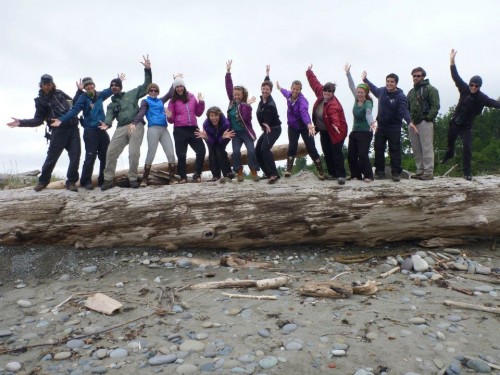 It only takes a few days in Forks, Washington, to be dead sure that the town is the rainiest place in the lower forty-eight. And that is exactly where we were headed for our Spring Graduate Retreat. To quell any suspicions that we were visiting for the purposes of Twilight histeria, let me say that while the prospect of vampires and warewolves may have been an exciting addition to our adventure for some, their anticipated sighting was far removed from our journey’s intent.
It only takes a few days in Forks, Washington, to be dead sure that the town is the rainiest place in the lower forty-eight. And that is exactly where we were headed for our Spring Graduate Retreat. To quell any suspicions that we were visiting for the purposes of Twilight histeria, let me say that while the prospect of vampires and warewolves may have been an exciting addition to our adventure for some, their anticipated sighting was far removed from our journey’s intent.
One of my fellow cohort 11 members aptly described the rejuvenating effects of our recent spring retreat as: “How I stopped worrying and learned to love the rain.” An elementary recollection perhaps, but one ripe with meaning for the 14 graduate students at North Cascades Institute who spent four days camped near the rainy coastline of the Olympic Peninsula. The purpose of our retreat was three-fold: to offer us a respite from a busy spring of teaching Mountain School, planning curriculum, and working on Natural History topics, to provide an opportunity for continued exploration of the natural world and, perhaps most importantly, to deepen our connections with each other and have fun together.
After nearly a year of crowding under trees as we drip water from our noses and our fingertips, we have all learned to stretch our definitions of fun. On this particular retreat, fun was found in many forms. How fun, to sketch the ocean’s horizon line as droplets of water hit our journal pages; how fun, to play touch football on the beach as wet granules of sand stick to our feet; how fun, to cook dinner under the jankity cover of a tarp as the rain whittles away at the woven plastic overhead; how fun, to huddle around a campfire and laugh together as water drips down our backs; how fun, to fall asleep to the sound of rain on tent surfaces; how fun, to wake up surrounded by a puddle built of last night’s downpour; how fun, to watch a sucker hole widen just long enough to warrant the happy shedding of rain gear; how fun, to recognize the urgency of rainfall as the requisite of life found in the wild diversity of the Olympics.
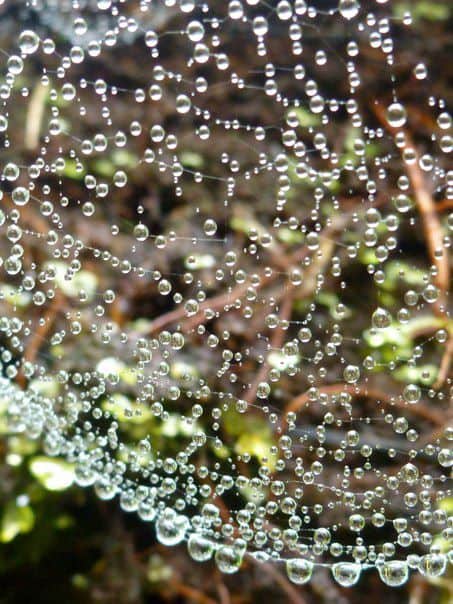 Beads of rain caught poetically in the intricate web left by a spider. Photo by Colby Mitchell.
Beads of rain caught poetically in the intricate web left by a spider. Photo by Colby Mitchell.
Our adventure began with a ferry ride to Port Townsend. It wasn’t but a few minutes blithely spent on the windy deck of the boat before we were shouting out the names of shorebirds spotted through binoculars – rhinoceros auklets, pelagic cormorants, and the famed marbled murrelet! Our naturalizing was already off to a great start. After disembarking from the ferry and heading along the north coast of the Olympics for a time, we stopped at Tongue Point to do some tide pooling. Being a naturalist of the mountain variety, I, for one, was giddy to be spending the afternoon exploring life below the water with others of my cohort who were far more knowledgeable about marine wildlife than I: California mussels, chiten, sea anenomes, hermit crabs, periwingle mollusks, gooseneck barnacles, kelps, and sea weeds – to name just a few of the myraid of species we discovered. It was deep breathing interjected with wild explanations of excitement as we examined the intricacies of tidal life while looking out across a great expanse of blue.
We set up camp that evening on the west coast of the peninsula. While the rain clouds did not break until we were curled in our tents, dampness hung in the air and clouds threatened dark and low. It was the perfect space to seek the warmth and naturalness of comraderie around a campfire.
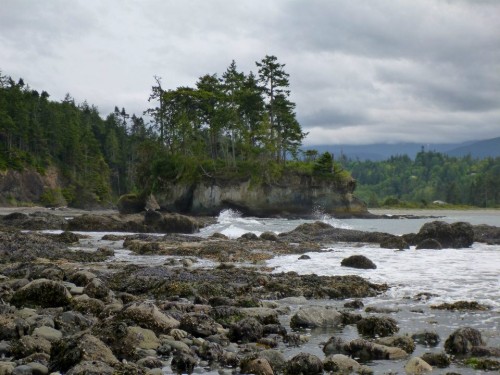 The dramatic beauty of the Olympic coastline off of Tongue Point. Photo by Jess Newley.
The dramatic beauty of the Olympic coastline off of Tongue Point. Photo by Jess Newley.
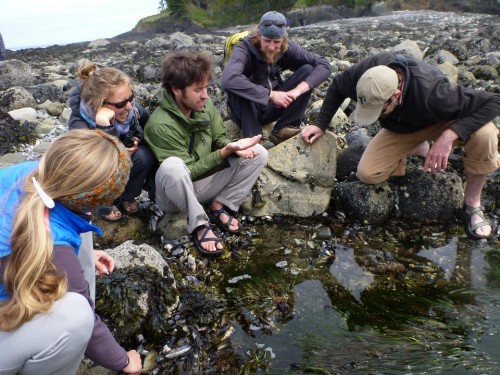 Graduate students watch an exciting battle ensue between hermit crabs and an unfortunate sea snail with Science Coordinator, Jeff Anderson. Photo by Jess Newley.
Graduate students watch an exciting battle ensue between hermit crabs and an unfortunate sea snail with Science Coordinator, Jeff Anderson. Photo by Jess Newley.
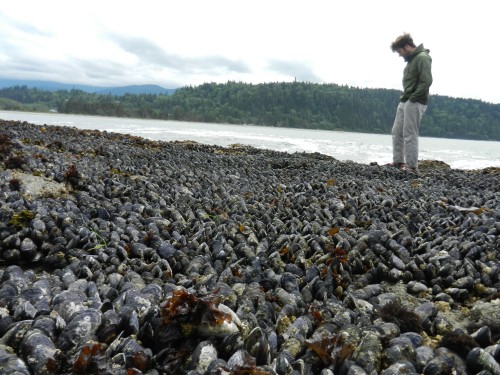 Jacob Belsher explores a prominent bed of California mussels. Photo by Kiira Heymann.
Jacob Belsher explores a prominent bed of California mussels. Photo by Kiira Heymann.
The second day of our retreat was spent with Pacific Northwest naturalist and friend of the Institute, Susan Zwinger. She guided our group through a wonderful process of journaling and reflection, where the naturalist/artist meditates on their subject and learns to truly see its essence. It was a welcome practice for all of us that prompted us to slow down, to observe the misty beaches around us, and to ask questions of what we were seeing as a means of further discovery. Whether our preferred mode of practice was journaling with a notebook and pen, snapping pictures, walking the coastline, or simply listening to the ubiquitous sound of the waves, each of us found the much needed space for personal reflection and connection. As our day ended, we dispersed across Rialto Beach, some scanning the shore for sea shells, others picking up binoculars to look for shorebirds, and still others playing a wet and silly game of football.
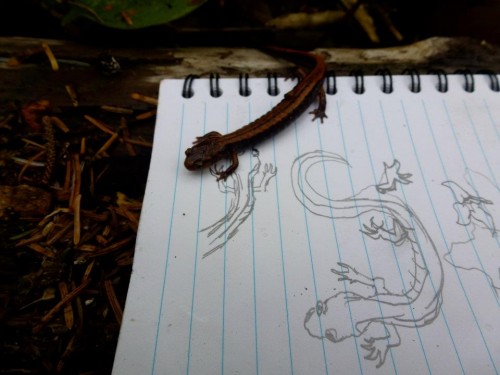 Sketching the lines and curves of a western red-backed salamander during a drawing exercise with Susan Zwinger. Photo by Alex Patia.
Sketching the lines and curves of a western red-backed salamander during a drawing exercise with Susan Zwinger. Photo by Alex Patia.
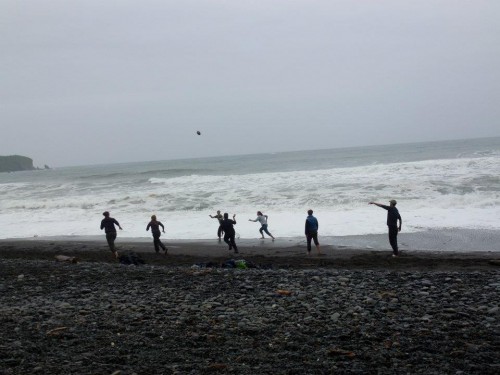 And the football game commences! Photo by Sarah Bernstein.
And the football game commences! Photo by Sarah Bernstein.
After two days spent on the coast, our cohort traveled inland to explore the Hoh Rainforest and spent the morning with the District Interpreter for Olympic National Park and the Hoh, Jon Preston. He was an enthusiastic and passionate educator, and led us on an animated hike through the forest. Jon described the Olympics as the giant nurturing mother of Washington’s National Parks, and the Hoh as a temperate rainforest never want for its most important nutrient, water. With an average annual precipitation of 137 inches, the Hoh is truly a landscape whose diverse plant and animal communities are uniquely adapted to being wet a significant portion of their lives. We walked in awe among the monolithic giants of the Olympics, the coastal Sitka Spruce, admiring their scaly bark and branching root masses. The abundance of hanging mosses covering every square inch of the understory added beauty and depth to an ancient, chaotic, and wet place. While exploring the forest with Jon we came across a rare discovery – the tiny nest of a rufous hummingbird constructed stubbornly between the branches of a western hemlock bough draped heavily over a creek. As we peered excitedly through binoculars, we were able to confirm at least two small chicks in the nest that the parent was attentively feeding! After relishing for a moment in our find, we moved further down trail to give the hummingbird some space.
A big leaf maple laden with mosses in the understory of the Hoh Rainforest. Photo by Colby Mitchell.
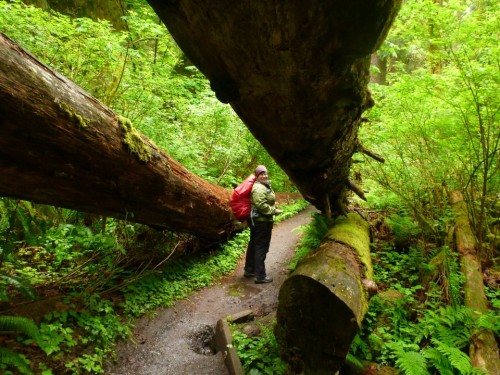 Erin Soper is all smiles as she naturalizes along a trail through the temperate rainforest. Photo by Jess Newley.
Erin Soper is all smiles as she naturalizes along a trail through the temperate rainforest. Photo by Jess Newley.
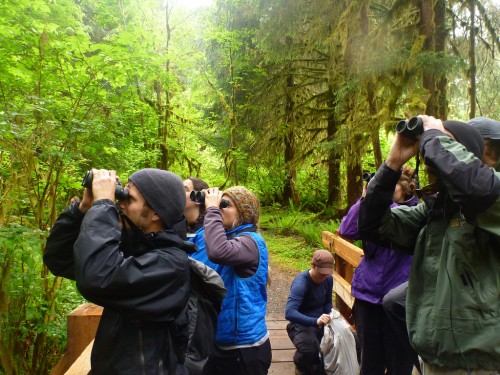 We are all silenced in wonder at the sight of a rufous hummingbird feeding her young in a nest no bigger than a tennis ball. Photo by Jess Newley.
We are all silenced in wonder at the sight of a rufous hummingbird feeding her young in a nest no bigger than a tennis ball. Photo by Jess Newley.
The final day of our adventure found us packing up our drenched tents and sticky sleeping bags and heading back towards home. With a good day of driving ahead of us and not a lot of incentive to stay huddled under the dripping tarp covering our cook area, we loaded into our cars for the Dungeness Spit on the north shore of the Olympic Peninsula. A five mile-long, natural sand spit formed over thousands of years by sea currents, Dungeness Spit is the perfect landscape for beach combing. And, because the spit creates a quiet harbor by buffering crashing waves, birds abound in its protected marine habitat. None of us made it very far before setting up the large spotting scope on pigeon guillemonts, serf scoters, common loons, cormorants, and even sea lions and harbor seals. Our shore bird list was climbing!
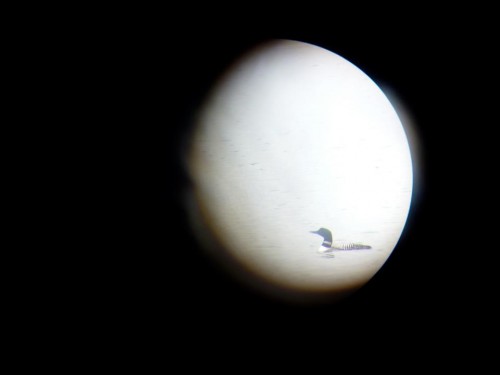 The common loon captured through our spotting scope at Dungeness Spit. Photo by Alex Patia.
The common loon captured through our spotting scope at Dungeness Spit. Photo by Alex Patia.
While a few hours spent at Dungeness Spit was hardly enough time to really explore the unique character of the marine reserve, our ferry, and the promise of dry beds, prompted us on. We loaded back into the vans a final time all, all of us feeling grateful for the week’s adventures. The spring graduate retreat had given us an opportunity to deepen our connection with the landscape of Washington and, incidentally, the state’s National Parks. The third of our graduate retreats, we cherish these intentional trips for the time to naturalize and connect with each other, to contemplate and reflect on our experience in this program, and to practice being fully present in the world. And, as was the case in this retreat, to learn to love the rain.
Leading photo of Cohort 11 giving spirit fingers at Dungeness Spit. Photo by Jess Newley.


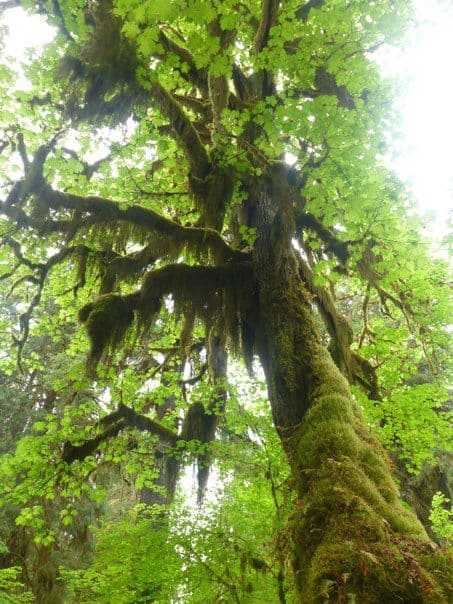
Great write up, Chris. Thanks for sharing.
That was so much fun to read. I love the way you describe things it sucks me right in and before I know it I am there with you loving the rain- though I must admit liking that I am in sunny california. Great blog.
Awesome. Looks like home!!!! Enjoy.
There’s no end to the exploration & naturalizing opportunities on the Oly Penn! Glad to be taken out there with you guys thru your writing and photos.
Awesome article Chris!